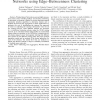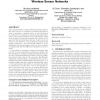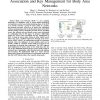57 search results - page 8 / 12 » SUMP: a secure unicast messaging protocol for wireless ad ho... |
ICC
2011
IEEE
12 years 7 months ago
2011
IEEE
Abstract—Wireless Sensor Networks are proven highly successful in many areas, including military and security monitoring. In this paper, we propose a method to use the edge–bet...
WINET
2011
13 years 2 months ago
2011
Sleep scheduling, which is putting some sensor nodes into sleep mode without harming network functionality, is a common method to reduce energy consumption in dense wireless sensor...
WISEC
2009
ACM
14 years 2 months ago
2009
ACM
Time synchronization in highly distributed wireless systems like sensor and ad hoc networks is extremely important in order to maintain a consistent notion of time throughout the ...
ICNP
2003
IEEE
14 years 23 days ago
2003
IEEE
Emerging large scale distributed networking systems, such as P2P file sharing systems, sensor networks, and ad hoc wireless networks, require replication of content, functionalit...
INFOCOM
2010
IEEE
13 years 4 months ago
2010
IEEE
Body Area Networks (BAN) is a key enabling technology in E-healthcare such as remote health monitoring. An important security issue during bootstrap phase of the BAN is to securely...



